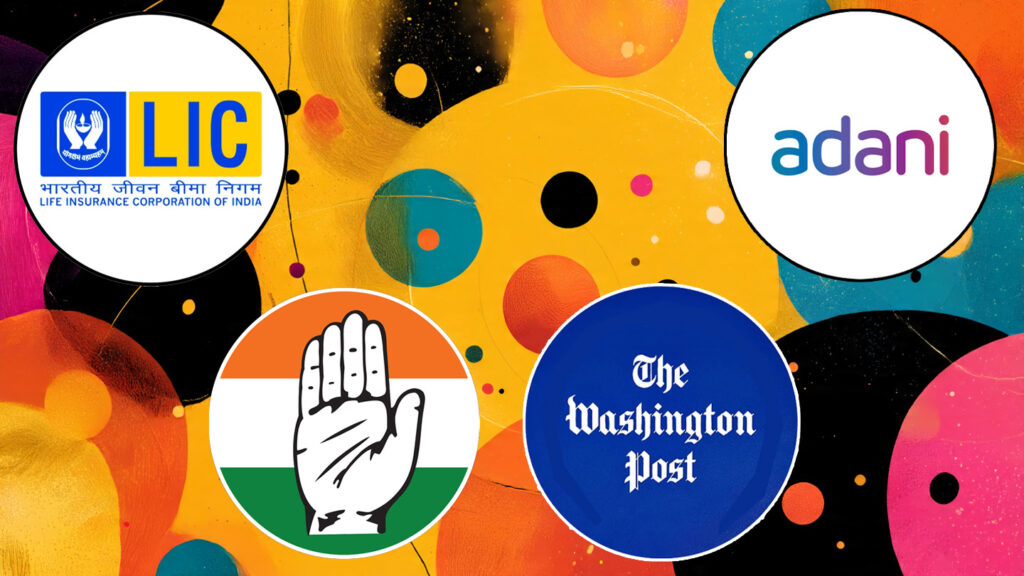After Washington Post published another hitjob against the Modi government, accusing it of forcing Life Insurance Corporation to invest in Adani shares, the Congress party thinks it has got a Brahmastra to attack the govt. The party has been using the allegations to target the govt, and has posted several memes on X.
3,30,00,00,00,000 रुपए मात्र pic.twitter.com/VB0nQALmHA
— Congress (@INCIndia) October 25, 2025
The party has posted several tweets from the official INC handle, such as one mockingly labelling the investment as “3,30,00,00,00,000 रुपए मात्र” (just 33,000 crore rupees) accompanied by a satirical image of Modi handing a giant LIC cheque to Gautam Adani, and quipping “Modi Hai To Mumkin Hai” (If Modi, then it’s possible) with a similar meme.
Modi Hai To Mumkin Hai pic.twitter.com/Ov5BlqhFzn
— Congress (@INCIndia) October 25, 2025
However, LIC has categorically denied these claims, stating that all investments, including a $570 million stake in Adani Ports & SEZ, rated ‘AAA’ by credit rating agencies, were made independently after “detailed due diligence” and with full integrity. Far from a loss-making favour as alleged by Washington Post and Congress, LIC’s Adani exposure actually yielded handsome returns. Notably, LIC’s stakes in other corporate conglomerates like Reliance (6.9%, Rs 1.3 lakh crore) and Tata (15.9%, Rs 82,800 crore) are much higher than its Adani holdings, but Congress party attacks only Adani group investments.
While Congress is busy making memes accusing Modi of handing over LIC money to Adani, it seems to have forgotten how its own government used LIC’s vast funds as its personal ATM. The UPA government, particularly during the second term, famously used LIC as a bailout buyer to meet the government’s ambitious disinvestment targets.
Facing twin deficits, failing disinvestment targets due to lackluster market interest in loss-making public sector undertaking (PSU) stocks and a ballooning fiscal shortfall, the Congress-led regime repeatedly forced LIC into buying such PSU stocks. Policyholders’ savings were funnelled into propping up government finances, often at lower returns, to window-dress books and meet arbitrary divestment targets.
While current LIC investments have been transparent and made good returns, UPA forcing the life insurer to participate in PSU disinvestments saddled it with losses. A 2013 Economic Times report states that LIC had lost over ₹3,000 crore in shares of several PSUs it had bought to bailout the government.
UPA’s disinvestment agenda was ambitious on paper but failed to get enough buyers from the private sector. With private investors shunning overpriced or underperforming PSU shares amid a sluggish economy, the government leaned heavily on LIC to absorb unsold stakes. As a result, disinvestment targets were met, but actually, it was a backdoor mechanism to claim “success” in privatization drives. This also allowed UPA govt to book revenues and improve the fiscal situation.
During the in UPA-II (2009-2014) government, LIC subscribed to 40-70% of several flagship Offer for Sale (OFS) and Follow-on Public Offer (FPO) issues, injecting over ₹30,000 crore to rescue flagging sales.
LIC was the leading investor in numerous cases. For instance, in 2010, LIC bailed out NTPC’s FPO by taking 49.48% of the offer, amounting to around ₹4,058 crore out of a total ₹8,200 crore issue, which was part of a combined Rs 10,000+ crore effort including NMDC. That same year, for NMDC’s FPO, LIC absorbed 63.72% or roughly ₹6,310 crore from the ₹9,900 crore mining stake sale, acting as the primary anchor amid weak bids. By 2012, in a follow-up OFS for NMDC, LIC picked up about 47% worth ₹278 crore from an estimated ₹597 crore offer, again compensating for minimal retail uptake.
The trend intensified in 2013 with a series of rescues. LIC took a whopping 96% or ₹12,179 crore of ONGC’s ₹12,700 crore OFS, marking the largest single buy in the oil and gas sector. For SAIL’s ₹1,500 crore OFS, LIC subscribed to 70.57% or about ₹1,058 crore, boosting its stake in the steel PSU to around 9%.
In NTPC’s February 2013 OFS, LIC accounted for roughly 49% with an investment of ₹1,765 crore of the approximately ₹3,570 crore offer. Additionally, for Hindustan Copper’s ₹1,225 crore OFS, LIC’s share was about 44% at ₹608 crore. Finally, in 2014, LIC fully absorbed BHEL’s ₹2,685 crore block deal, acquiring a 5.94% stake and pushing its holding in the engineering PSU to 14.99%.
These were not isolated investments, they formed a pattern where LIC’s subscriptions ensured UPA met ₹40,000 crore annual targets, even as global investors turned away. Unlike Adani’s high-growth companies, many of these PSUs underperformed, eroding LIC’s corpus value.
Not just disinvestments, UPA made even worse use of LIC, to hide high fiscal deficits, which reached 6.5% of GDP in 2011-12. With borrowing costs soaring and bond markets unwilling to take govt papers, the government treated the insurer as a “captive source of funds,” directing it to buy long-term bonds, recapitalize failing banks, and infuse capital into loss-making PSUs like Air India and BSNL.
In the later years of UPA-II govt, LIC bailed out several PSU banks suffering from high NPAs, by investing in equities and bonds. LIC was a major buyer of oil bonds worth thousands of crores issued by the UPA govt. These oil bonds were deferred liabilities that burdened future budgets.
This is not that LIC stopped buying PSU stocks during NDA government, but those are regular investments, not bailouts like earlier. The insurers investments into private equities and bonds, including those of Adani group, are also part of such regular investments, to generate return on its funds.
Moreover, LIC is known to invest on reputed stocks when they are down, and then selling them when the prices rise. This may seem counterintuitive for stock market investment, but for conservative investment policy of LIC, this strategy fits perfectly. That is why they invested in Adani stocks when they were down after Hindenburg allegations.

